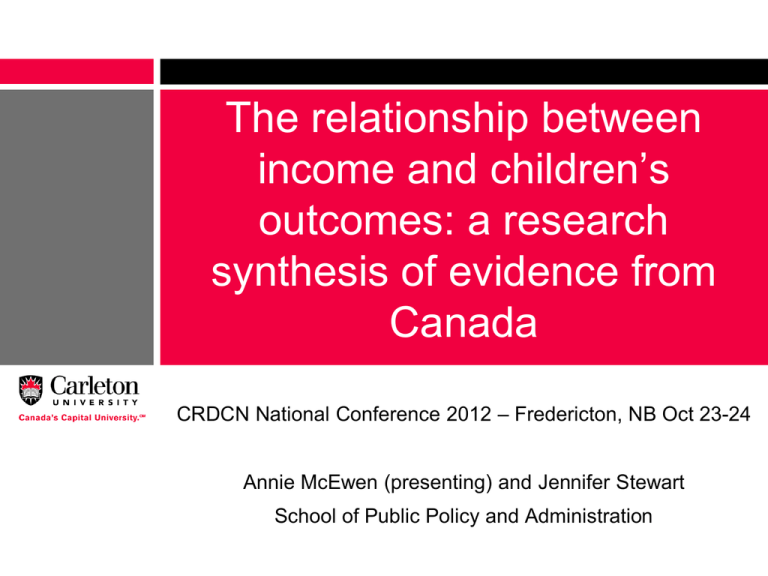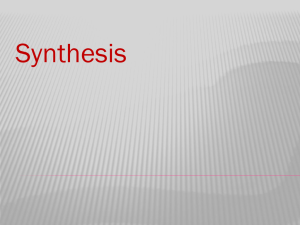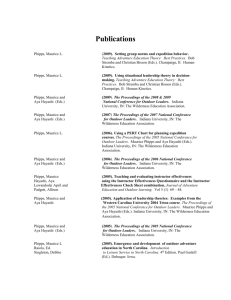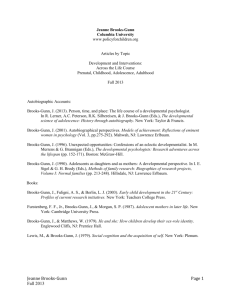The relationship between income and children*s outcomes: a
advertisement

The relationship between income and children’s outcomes: a research synthesis of evidence from Canada CRDCN National Conference 2012 – Fredericton, NB Oct 23-24 Annie McEwen (presenting) and Jennifer Stewart School of Public Policy and Administration Outline • CRDCN Research Syntheses • Why a child outcomes synthesis? • Synthesis focus and research questions • Criteria for research inclusion • Family income and cognitive outcomes • Methodologies • Data • Policy implications • Research implications • Questions and next steps 2 A CRDCN Synthesis Project • peer-reviewed publications written by subject specialists • available in English and French • written in plain language suitable for a general audience • assess the strength and implications of existing empirical research in relation to key policy questions 3 CRDCN Synthesis Objectives • ensure that research results are absorbed by policy-makers and the public; • help ensure that the RDC program and Statistics Canada’s surveys contribute to the development and adoption of knowledge-informed policy; • identify key evidence gaps in order to encourage policy-relevant research For more information see: http://www.rdc-cdr.ca/sites/default/files/crdcn_research_syntheses.pdf 4 Why a synthesis on income and child outcomes? • Policy & public attention to children and child development research eg. child care (UCCB), allday-kindergarten • Increasing concern about roots of inequality and social mobility in childhood • A focus on child development as ‘human capital’ • Research affects how policy views children • NLSCY completion: how far have we gotten in understanding this relationship? 5 Synthesis research questions 1. How has income been shown to affect different dimensions of child outcomes (e.g. health, behaviour, educational attainment)? 2. What variables have been found to either moderate or mediate the effect of income on child outcomes? 3. What methods have studies used to examine the causality of the relationship between income and outcomes, and how effectual have they been? 4. What are future data needs and research directions? 6 Criteria for inclusion • Canadian data: – National Longitudinal Survey of Children and Youth (NLSCY) – L’Étude longitudinale du développement des enfants du Québec – Youth in Transition Survey (YITS) – Ontario Child Health Survey (OCHS) • Income as key independent variable (not just control) or major part of findings • Longitudinal element in data analysis • Outcome areas: Cognitive, Social-emotional, Behavioural, Physical/Health 7 Income & Cognitive Outcomes: Main effects • Cognitive outcomes: – – – – Pearson-Peabody Vocabulary Test (Revised) Math and reading tests Standardized (provincial) curriculum test Grade completion, high school completion, PSE • Undisputed association, but cause and magnitude? • High intergenerational income mobility in Canada, three times that of USA (Corak, Curtis, and Phipps 2011) • Magnitude of ‘direct’ income effect smaller once other SES factors taken into accounted (Curtis and Phipps 2000; Dooley and Stewart 2004, 2007, Blau 1999, Mayer 1997) • Income has little effect on post-secondary education choices (Lefebvre and Merrigan 2008, 2010) 8 Income & Cognitive Outcomes: Mediation • Parenting style (Thomas 2006, Guo and Mullan Harris 2000) • Parental time (Curtis and Phipps 2000, Duncan et al. 2010) • Source of income (Dooley and Stewart 2004, 2007) • Child activities/spending (Thomas 2006, Yeung et al. 2002) • Child and parent health (Contoyannis and Dooley 2010) • Family emotional well-being (Milligan and Stabile 2008, 2009) 9 Income & Cognitive Outcomes: Patterns • Stronger correlation between income and cognition than other outcomes (Phipps and Lethbridge 2006, Duncan and Brooks-Gunn 1997) • Trajectories and persistence (Lloyd and Hertzman 2009, Santos et al. 2012, Hoddinnott et al. 2002, Roberts et al. 2001) • Timing matters, early poverty worse (Hoddinnott et al. 2002, Duncan and Brooks-Gunn 1997) • Gendered impacts – bigger cognitive effect for boys (Milligan and Stabile 2008) • Duration of low-income matters. High turnover for kids, but persistent poverty more strongly correlates with worse outcomes (Phipps and Lethbridge 2006, Hoddinnott et al. 2002) Roberts et al. 2001) 10 Methodologies • Difficulty of managing unobserved heterogeneity • Use of exogenous policy changes, before/after and diff-in-diffs (Milligan and Stabile 2008, 2009; Williamson and Salkie 2005, Lefebvre and Merrigan 2002, 2008, 2011, Dooley and Stewart 2007) • Fixed effects, adoptive/biological, income treatments (Dooley and Stewart 2004, 2007, Mayer 1997) • Diverse income measures: permanent/averages, cross-sectional, lagged, pre-/post-transfer and tax, earned/social assistance, census area SES • Functional form of income used matters, and may change with age (Phipps and Lethbridge 2006) 11 Issues with Canadian data • How good are these cognitive measures? • Direct observations/tests vs. reporting • Inclusion of policy within data collection vs. imputation– which programs are individuals actually using? • Need for longitudinal data with more frequent and longer follow-up • Sampling and attrition – difficulty accounting for bias • Need for census for reference group/weighting • Child expenditure measures, connected to outcomes • Blind spots: First Nations children, children out of family • Administrative data? Linking? (BC & Manitoba EDI) 12 Policy implications: Cognitive outcomes “Policies that affect family income will have little direct impact on child development unless they result in very large and permanent changes in income” (Blau 1999, USA) • Value of income transfers for direct effects on cognition are small. Indirect effects hard to pinpoint. • Evidence of parenting/family functioning mediation supports family services and programs as alternatives to income transfers (efficiency unclear). • Varying effect of income at different ages of childhood supports differentiation in policies for different ages, rather than 0-18 (eg. child benefits) • Trajectories set early, potential for targeted programs • Kids can change trajectories, no clear “too late” point 13 Filling Canadian research gaps • Emphasis to date on younger kids – IQ, ‘school readiness’ rather than outcomes or academic attainment • How important are cognitive outcomes and how do they connect with other factors? (Tough 2012) • Population level research, environmental, peer or school effects (Lloyd and Hertzman 2009, Santos et al. 2012) • Dynamic research – what are the effects of change? • Differentiating between earned and transferred income • Income vs. wealth or assets 14 Questions • Are there studies/data we should be including? • What do you see as the research/data gaps in this area? • What policy implications can we draw? 15 Next steps and contact info • Completion of literature review, annotated bibliography and synthesis drafting • Peer review of synthesis by CRDCN • Publication to CRDCN website and policy journal (Spring 2013) Annie McEwen and Jennifer Stewart School of Public Policy and Administration, Carleton University, Ottawa anne_mcewen@carleton.ca jennifer_stewart@carleton.ca 16 References (presentation, not complete synthesis) Blau, David (1999), 'The effect of income on child development', Review of Economics and Statistics, 81 (2), 261-76. Contoyannis, Paul and Dooley, Martin (2010), 'The role of child health and economic status in educational, health, and labour market outcomes in young adulthood ', Canadian Journal of Economics/Revue canadienne d'économique, 43 (1), 323-46. Corak, Miles, Curtis, Lori, and Phipps, Shelley (2011), 'Economic Mobility, Family Background, and the Well-Being of Children in the United States and Canada', in Timothy M. Smeeding, Robert Erikson, and Markus Jänti (eds.), Persistence, Privilege, and Parenting (Russell Sage Foundation), 73-108. Curtis, Lori and Phipps, Shelley (2000), 'Economic Resources and Children’s Health and Success at School: An Analysis Using the NLSCY', in Human Resources Development Canada (ed.), (Ottawa: Human Resources Development Canada). Dooley, Martin and Stewart, Jennifer (2004), 'Family income and child outcomes in Canada', Canadian Journal of Economics, 37 (4), 898-917. --- (2007), 'Family income, parenting styles and child behavioural-emotional outcomes', Health Economics, 16 (2), 145-62. Duncan, Greg J. and Brooks-Gunn, Jeanne (1997), Consequences of growing up poor (New York: Russell Sage Foundation). Duncan, Greg J., Kalil, Ariel, and Ziol‐Guest, Kathleen (2010), 'Early‐Childhood Poverty and Adult Attainment, Behavior, and Health', Child Development, 81 (1), 306-25. Guo, Guang and Mullan Harris, Kathleen (2000), 'The Mechanisms Mediating the Effects of Poverty on Children’s Intellectual Development', Demography, 37 (4), 431-47. Hoddinnott, John, Lethbridge, Lynn, and Phipps, Susan (2002), 'Is History Destiny? Resources, Transitions and Child Education Attainments in Canada', (Ottawa: Human Resources Development Canada). Lefebvre, Pierre, Merrigan, Philip, and Roy-Desrosiers, Francis (2011), 'Quebec's Childcare Universal Low Fees Policy 10 Years After: Effects, Costs and Benefits', Centre Interuniversitaire sur le Risque, les Politiques Economiques et l'Emploi (CIRPEE) Working Paper. <http://ideas.repec.org/p/lvl/lacicr/1101.html%3E, accessed May 2011. Lloyd, Jennifer E. V. and Hertzman, Clyde (2009), 'From Kindergarten readiness to fourth-grade assessment: Longitudinal analysis with linked population data', Social Science & Medicine, 68 (1), 111-23. 17 References cont’d (presentation, not complete synthesis) Mayer, Susan E. (1997), What money can't buy: family income and children's life chances (Cambridge: Harvard University Press). McEwen, Annie (2011), 'Beyond child poverty: following the evidence to a multidimensional approach to childhood disadvantage', in Guy Fréchet, Danielle Gauvreau, and Jean Poirier (eds.), Social Statistics, Poverty and Social Exclusion: Perspectives from Quebec, Canada and Abroad (Montreal: Les Presses de l’Universite de Montreal). Milligan, Kevin and Stabile, Mark (2008), 'Do Child Tax Benefits Affect the Wellbeing of Children? Evidence from Canadian Child Benefit Expansions', NBER Working Paper Series, No. 14624. --- (2009), 'Child Benefits, Maternal Employment, and Children's Health: Evidence from Canadian Child Benefit Expansions', American Economic Review, 99 (2), 128. Phipps, Shelley and Lethbridge, Lynn (2006), 'Income and the Outcomes of Children', in Statistics Canada (ed.), Analytical Studies Branch Research Paper Series (Ottawa: Statistics Canada). Roberts, Paul, Smith, Peter, and Nason, Holly (2001), 'Children and Familial Economic Welfare: The Effect of Income on Child Development', in Applied Research Branch Strategic Policy Human Resources Development Canada (ed.), (Ottawa). Santos, Rob, et al. (2012), 'The Early Development Instrument (EDI) in Manitoba: Linking Socioeconomic Adversity and Biological Vulnerability at Birth to Children’s Outcomes at Age 5', in Manitoba Centre for Health Policy (ed.), (Winnipeg, MB). Thomas, Eleanor (2006), 'Readiness to Learn at School Among Five-year-old Children in Canada', Children and Youth Researcher Series (Ottawa: Statistics Canada). Tough, Paul (2012), How Children Succeed: Grit, Curiosity, and the Hidden Power of Character (Boston: Houghton Mifflin Harcourt). Williamson, Deanna L. and Salkie, Fiona (2005), 'Welfare reforms in Canada: Implications for the well-being of pre-school children in poverty', Journal of Children & Poverty, 11 (1), 55-76. Yeung, W. Jean, Linver, Miriam, R. , and Brooks-Gunn, Jeanne (2002), 'How money matters for young children's development: Parental investment and family processes', Child development, 73 (6), 1861-79. 18







